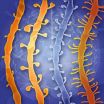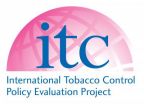(Press-News.org) HEIDELBERG, 3 August 2012 – Intellectual disability due to Fragile X and Down syndromes involves similar molecular pathways report researchers in The EMBO Journal. The two disorders share disturbances in the molecular events that regulate the way nerve cells develop dendritic spines, the small extensions found on the surface of nerve cells that are crucial for communication in the brain.
"We have shown for the first time that some of the proteins altered in Fragile X and Down syndromes are common molecular triggers of intellectual disability in both disorders," said Kyung-Tai Min, one of the lead authors of the study and a professor at Indiana University and the Ulsan National Institute of Science and Technology in Korea. "Specifically, two proteins interact with each other in a way that limits the formation of spines or protrusions on the surface of dendrites." He added: "These outgrowths of the cell are essential for the formation of new contacts with other nerve cells and for the successful transmission of nerve signals. When the spines are impaired, information transfer is impeded and mental retardation takes hold."
Intellectual disability is a developmental brain disorder that leads to impaired cognitive performance and mental retardation. Two of the most prevalent genetic causes of intellectual disability in humans are Fragile X and Down syndromes. Fragile X syndrome arises from a single gene mutation that prevents the synthesis of a protein required for neural development (Fragile X mental retardation protein). The presence of all or a part of a third copy of chromosome 21 in cells causes Down syndrome. Although both syndromes arise due to these fundamental genetic differences, the researchers identified a shared molecular pathway in mice that leads to intellectual disability for both disorders.
The mice that were used in the experiments are model systems for the study of Fragile X syndrome and Down syndrome. Down syndrome mice have difficulties with memory and brain function, and the formation of the heart is often compromised, symptoms that are also observed in humans with Down syndrome. Both model systems are very useful to scientists looking to dissect the molecular events that occur as the disorders take hold.
The scientists revealed that the Down syndrome critical region 1 protein (DSCR1) interacts with Fragile X mental retardation protein (FMRP) to regulate dendritic spine formation and local protein synthesis. By using specific antibodies that bind to the proteins as well as fluorescent labeling techniques they showed that DSCR1 specifically interacts with the phosphorylated form of FMRP. The overlapping molecular pathways of intellectual disability in both genetic disorders suggest that a common therapeutic approach might be feasible for both syndromes.
Min remarked: "We believe these experiments provide an important step forward in understanding the multiple roles of DSCR1 in neurons and in identifying a molecular interaction that is closely linked to intellectual disability for both syndromes."
DSCR1 interacts with FMRP and is required for spine morphogenesis and local protein synthesis
INFORMATION:
Wei Wang, John Z. Zhu, Karen T. Chang, Kyung-Tai Min
Read the paper:
doi:10.1038/emboj.2012.190
Further information on The EMBO Journal is available at
http://www.nature.com/emboj/index.html
Media Contacts
Barry Whyte
Head | Public Relations and Communications
Yvonne Kaul
Communications Offer
Tel: +49 6221 8891 108/111
communications@embo.org
About EMBO
EMBO stands for excellence in the life sciences. The organization enables the best science by supporting talented researchers, stimulating scientific exchange and advancing policies for a world-class European research environment.
EMBO is an organization of 1500 leading life scientist members that fosters new generations of researchers to produce world-class scientific results. EMBO helps young scientists to advance their research, promote their international reputations and ensure their mobility. Courses, workshops, conferences and scientific journals disseminate the latest research and offer training in cutting-edge techniques to maintain high standards of excellence in research practice. EMBO helps to shape science and research policy by seeking input and feedback from our community and by following closely the trends in science in Europe.
For more information: www.embo.org
Fragile X and Down syndromes share signalling pathway for intellectual disability
2012-08-03
ELSE PRESS RELEASES FROM THIS DATE:
Aurka-to-p53 signaling: A link between stem cell regulation and cancer
2012-08-03
Researchers at Mount Sinai School of Medicine, the University of Manchester, and the MD Anderson Cancer Center have found a new role for an oncogenic signaling pathway in embryonic stem cell (ESC) self-renewal and in reprogramming adult cells into an ESC-state, which will aid in the development of future cancer therapies.
The findings promote the understanding of the self-renewal mechanism in embryonic stem cells and provide insight into the role of Aurka, an oncoprotein that is amplified in several human cancers. The research is published in the August 3rd issue of ...
Birds that live with varying weather sing more versatile songs
2012-08-03
Durham, NC — A new study of North American songbirds reveals that birds that live with fluctuating weather are more flexible singers.
Mixing it up helps birds ensure that their songs are heard no matter what the habitat, say researchers at Australian National University and the National Evolutionary Synthesis Center.
To test the idea, the researchers analyzed song recordings from more than 400 male birds spanning 44 species of North American songbirds — a data set that included orioles, blackbirds, warblers, sparrows, cardinals, finches, chickadees and thrushes.
They ...
Ancient records shed light on Italian earthquakes (Aquila area)
2012-08-03
When a damaging earthquake struck the area of L'Aquila in central Italy in 2009, it was the latest in the region's long history of strong and persistent quakes. The rich recorded history of settlement in the area, along with oral traditions, archaeological excavations, inscriptions and medieval texts, and offer insight into how often the region might expect destructive earthquakes. But according to a new study by Emanuela Guidoboni and colleagues, the historical record on ancient and medieval earthquakes comes with its own shortcomings that must be addressed before the ...
Catching the cap-snatcher
2012-08-03
Researchers at the European Molecular Biology Laboratory (EMBL) in Grenoble, France, have determined the detailed 3-dimensional structure of part of the flu virus' RNA polymerase, an enzyme that is crucial for influenza virus replication. This important finding is published today in PLoS Pathogens. The research was done on the 2009 pandemic influenza strain but it will help scientists to design innovative drugs against all the different influenza strains, and potentially lead to a new class of anti-flu drugs in the next 5-10 years.
The scientists focused on the endonuclease ...
Aerial photos reveal dynamic ice sheet
2012-08-03
Despite the current and rapid melting of the Greenland Ice Sheet, it remains far from certain just when we will have reached a point when scientists will be able to predict its disappearance. Recent research conducted by the University of Copenhagen in conjunction with the Technical University of Denmark (DTU) and the Danish National Survey and Cadastre (KMS) in collaboration with an international team of scientists reports that this is not the first time in recent history that the ice sheet has been in retreat and then stabilised again. The researchers' results have just ...
Alzheimer's cognitive decline slows in advanced age
2012-08-03
The greatest risk factor for Alzheimer's disease (AD) is advancing age. By age 85, the likelihood of developing the dreaded neurological disorder is roughly 50 percent. But researchers at the University of California, San Diego School of Medicine say AD hits hardest among the "younger elderly" – people in their 60s and 70s – who show faster rates of brain tissue loss and cognitive decline than AD patients 80 years and older.
The findings, reported online in the August 2, 2012 issue of the journal PLOS One, have profound implications for both diagnosing AD – which currently ...
Plant-based compound slows breast cancer in a mouse model
2012-08-03
The natural plant compound phenethyl isothiocyanate (PEITC) hinders the development of mammary tumors in a mouse model with similarities to human breast cancer progression, according to a study published August 2 in the Journal of the National Cancer Institute.
Edible plants are gaining ground as chemopreventative agents. PEITC has shown to be effective as a chemopreventative agent in mice for colon, intestinal, and prostate cancer, by inducing apoptosis.
In order to determine the efficacy of PEITC in mammary tumors in mice, Shivendra V. Singh, Ph.D., of the University ...
Cuckoo tricks to beat the neighborhood watch
2012-08-03
To minimise the chance of being recognised and thus attacked by the birds they are trying to parasitize, female cuckoos have evolved different guises. The new research, funded by the Natural Environment Research Council, was published today, 03 August, in the journal Science.
The common cuckoo (Cuculus canorus) lays its eggs in the nests of other birds. On hatching, the young cuckoo ejects the host's eggs and chicks from the nest, so the hosts end up raising a cuckoo chick rather than a brood of their own. To fight back, reed warblers (a common host across Europe) have ...
Breast cancer charity under fire for overstating the benefits of screening
2012-08-03
Professors Lisa Schwartz and Steven Woloshin of the Center for Medicine and the Media at The Dartmouth Institute for Health Policy and Clinical Practice argue that last year's breast cancer awareness month campaign by Susan G Komen for the Cure "overstates the benefit of mammography and ignores harms altogether."
Their views are published on bmj.com today as part of an occasional series highlighting the exaggerations, distortions, and selective reporting that make some news stories, advertising, and medical journal articles "not so."
A growing and increasingly accepted ...
5-year survey confirms Uruguay's world-leading tobacco control strategy is delivering results
2012-08-03
Implementation of graphic labels at 80% of the pack size front and back led to increased awareness of the risks of smoking
Ban on multiple brand presentations reduced smokers' false beliefs that some cigarettes (e.g., "light" or "mild" cigarettes) are less harmful
Strong support for tobacco control policies among smokers
(Thursday August 2nd, 2012, Montevideo, Uruguay and Waterloo, Ontario, Canada): The International Tobacco Control Policy Evaluation Project (the ITC Project) today launched a new report on the effectiveness of tobacco control policies in Uruguay. ...

